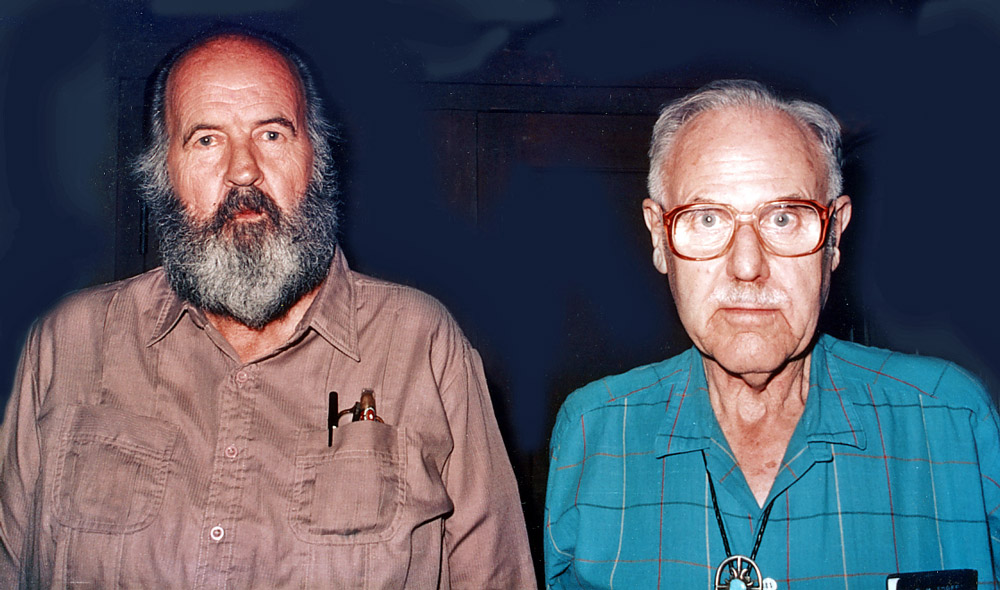Tale of Two Chucks

Chuck Lowe and Chuck Bogert at a meeting of the Tucson Herpetological Society hosted at the home of Dave and Billie Hardy in ca 1990. The print was scanned and edited by Carol Townsend and Tom Van Devender from a photo by Dave Hardy.
Robert L. Bezy
Natural History Museum of Los Angeles County
Animosities were an integral part of Chuck Lowe’s colorful personality and his relationship with Chuck Bogert was a prime example. During our all-nighters working in the lab, Lowe occasionally spoke of such things. This was well over a half century ago and my recollections here undoubtedly have been obscured by the sands of time.
From his recounting I gather that as an undergraduate student at UCLA Lowe was Ray Cowles’ “fair haired boy” and came to view himself as the heir apparent of his mentor’s grand view of the role of temperature in the evolution of desert reptiles. When Bogert arrived as a graduate student, he quickly displaced Lowe as Cowles’ favorite. At the American Museum of Natural History Bogert went on to become the champion of behavioral thermal regulation in reptiles, as first articulated by Cowles in 1940 and greatly elaborated upon by Cowles and Bogert in their 1944 AMNH bulletin. He appears to have convinced the Schultheis company in New York to produce the rapid reading thermometer that soon became the standard tool of the trade for the burgeoning “noose’em and goose’em” field of herpetology. Lowe brought the zeal for thermal ecology to the creosote league when he arrived at the University of Arizona in 1950, but his jealousy of Bogert persisted long afterwards.
From his midnight ramblings I gathered that another reason for Lowe’s animosity was his café sessions with Chuck and Mickey Bogert when they visited Tucson during their summer field work centered in the Chiricahua Mountains. He recounted how Bogert would comment, for example, that Masticophis flagellum cingulum Lowe and Woodin 1954 (Sonoran Coachwhip) was just a figment of Lowe’s imagination and he would eventually “have to come out here and straighten this whole mess out.” Lowe seemed grateful to Mickey for doing her best to smooth out Chuck’s abrasive comments.
I got to know Chuck and Mickey Bogert briefly in 1967. Jay Cole and I based our field and lab work in Oaxaca that summer and visited the Bogerts several times at the Oaxaca Courts where they lodged. Although Bogert and Lowe were quite different in personality in many ways, I was struck by their similar tendency to brashly express strong negative opinions. Certainly not hard to imagine how they would clash.
The only time I saw the two Chucks together was at a SSAR meeting in Albuquerque in 1971 which featured a symposium on thermal ecology. Lowe complained that Bogert followed him around wherever he went. At the banquet Roy McDiarmid thanked them both for their rare attendance at a national meeting and I like to imagine that the two Chucks left as friends, although the above photo taken years later does not appear to support that hypothesis.
References
Bezy, R.L. 2010. Desert Iguana, Dipsosaurus dorsalis (Baird and Girard, 1852). Sonoran Herpetologist 23:136-142.
Cowles, R.B. 1940. Additional implications of reptilian sensitivity to high temperatures. American Naturalist 74:542-561.
Cowles, R.B., and C.M. Bogert. 1944. A preliminary study of the thermal requirements of desert reptiles. Bulletin of the American Museum of Natural History 83:261-296.
Moll, E.O., and M. Rubio. 2006. Patronyms of the Pioneer West. Bogertophis subocularis (Brown, 1901), Trans-Pecos Ratsnake. Sonoran Herpetologist 19:110-114.
Myers, C.W., and R.G. Zweifel. 1993. Biographical sketch and bibliography of Charles Mitchill Bogert, 1908-1992. Herpetologica 49:133-146.
Pough, F.H. 1974. Preface. Pages i-iv in the 1974 reprint of Cowles, R.B. and C.M. Bogert. 1944. A preliminary study of the thermal requirements of desert reptiles. SSAR.
Rosen, P.C. 2004. Charles Herbert Lowe, Jr. 1920-2002. Copeia 2004:9